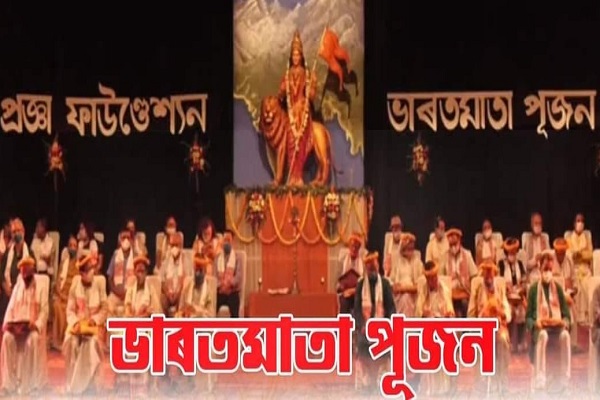
By Nava Thakuria
Come 19 October 2023 (1 Kati of 1430 Bhaskarabda) and art connoisseurs along with the patriotic citizens in the far eastern part of Bharat (India) will gather at Chandmari AEI field in Guwahati to celebrate the legacy, culture and traditions of the great land, as a five-day long festival will unfold a series of programs including Akhand Bharat Parikrama, Guru Pujan, Kanya Pujan, Mohiyasi Matri Sanman presentation, Vande Mataram dance competition, Alpana contest, puppet shows, folk musical performance, mime shows, exhibition and splendid cultural functions.
Organised under the initiative of Pragnya, the Bharat Mata Pujan 2023 will also witness a group performance on the theme of Vande Mataram with 500 participating artistes and also the traditional string puppet theatres from Assam will entertain the children every evening on the ground.
Worshiping the motherland as a deity may be unusual for other nations on Earth, but the people of India continued calling the sacred land as Bharat Mata (or Bharatamba) since time immemorial. The national personification of India as a mother goddess gained momentum during the freedom movement, where Bankim Chandra Chattopadhyay introduced a hymn titled ‘Vande Mataram’ in his Bengali language novel ‘Anand Math’ (1882) and Kiran Chandra Bandyopadhyay performed a play titled ‘Bharat Mata’ in 1873. Since then Bharat Mata symbolises an unified motherland (Akhanda Bharat) for millions of Indians.
Abanindranath Tagore, the eminent artist nephew of Rabindranath Tagore, portrayed Bharat Mata as a Hindu goddess in a 1905 painting. The four-armed deity, wearing saffron coloured traditional garments, carried a book, an Akshmala, sheaves of rice and a piece of white cloth (symbolising Shiksha, Diksha, Anna & Bastra). Bharat Mata as a Devi was also drawn on the cover of Tamil language magazine ‘Vijaya’ (edited by poet Subramania Bharati) in 1909. Inspired by the great sons of the soil, Bharat Mata is created as a goddess with red-coloured sari holding a saffron flag and standing on a lotus with an accompanying lion. The background depicts Akhand Bharat comprising present day Afghanistan, Pakistan, Sri Lanka, Maldives, Nepal, Tibet, Bhutan, Bangladesh and Myanmar as well.
Organising a celebration to worship the motherland in the region was always a challenge, as a larger population of this region pursued the idea of separate lands arguing that this part of the world came under the political Indian territory only after the 1826 Yandabo peace treaty (between the colonial British and Burmese invaders). Even though many Assamese freedom fighters sacrificed in the national movement, a number of separatist militant outfits preached for independence (ouf of India) and they often adopted violent means to manipulate the people in their favour. They even succeeded in misguiding the indigenous population for some decades with the inherent support from anti-Bharat campaigners (including intellectuals and editor-journalists).
There was a time when the armed militants dictated the people not to celebrate the national occasions like Independence Day and Republic Day in the region ( terming it the western part of southeast Asia). But a small group of scribes and patriotic citizens broke the diktat two & half decades back and started observing both the auspicious days with an aim to pay tributes to numerous freedom fighters, who made supreme sacrifices to make India a sovereign nation, by hoisting/unfurling the national tri-colour. The bold initiative by those patriotic individuals of Assam slowly helped change the mindset of a larger section of people in the society. It now keeps rolling with the initiative of concerned authorities and nationalist civil society organisations like Pragnya.
(The author is an eminent journalist based in Guwahati)



